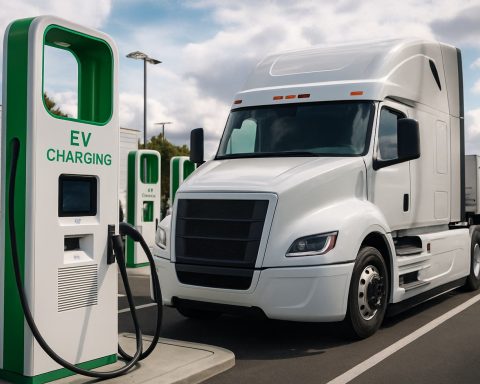- Charging networks like Blink Charging are crucial to the EV transition, but recent incidents expose serious system vulnerabilities.
- A $515 million billing error for a single user highlights the potential consequences of unreliable software and inadequate customer support.
- Automated customer service failed to resolve the issue, leading to frustration and raising concerns about accountability in tech-heavy infrastructure.
- Blink’s rapid expansion is shadowed by financial instability, with a reported 70% bankruptcy risk, workforce cuts, and organizational shake-ups.
- Consumer trust in EV charging networks depends as much on technical reliability and responsive service as on the number of charging stations installed.
- Building a dependable, transparent charging ecosystem is essential for the widespread adoption and long-term success of electric vehicles.
Parking an electric vehicle and plugging in for a quick charge should feel seamless, almost invisible—a quiet moment on the road to somewhere else. But for one EV driver, that routine top-up transformed into an unexpected headline: a bill so astronomically high that it dwarfed not just the cost of charging, but the entire market value of the charging company itself.
A mere 6 kilowatt-hours—the energy to power a few evening chores—allegedly cost $515 million, a number that leaps off the screen like a finance minister’s worst nightmare. It’s hard to decide what’s more shocking: the mind-boggling total, or the slow, unresponsive tech support that followed.
One Customer, One Outrageous Bill
Charging networks, lauded as a bridge to the clean-transportation future, rely on technology just as fragile and human as anything else. When the aforementioned user attempted to fix their predicament, robotic responses rerouted them endlessly. Calls left them languishing on hold. Eventually, support landed not in billing or technical help, but in the sales department—a digital dead-end.
This isn’t merely a harmless tech hiccup. Such incidents highlight why consumer trust in Blink Charging and other networks wavers as adoption expands. Blink, buoyed by its milestone of installing over 100,000 charging stations worldwide and reports of 33% annual growth in its owned network, trumpets its presence as a leader. Yet, the software at the heart of this prosperity—a proprietary, cloud-based platform—is only as reliable as the engineers behind it.
A Financial House of Cards?
While Blink races ahead with Level 2 chargers in dense city grids and plans to triple its Maryland manufacturing capacity, its foundation appears less stable. Financial analytics peg Blink’s risk of bankruptcy at an unnerving 70%. In response, the company announced layoffs of 20% of its workforce and a major leadership reshuffle, with restructuring experts now steering the helm. The gap between bold projections and operational reality has never felt wider.
The magnitude of the mistaken bill—seven times Blink’s own market cap—isn’t just an accounting error. It acts as a mirror: a reflection of the tension between rapid expansion and systems that buckle under unusual circumstances. Consumers, entrusting thousands of dollars or more to these networks over the years, demand not just transparency, but accountability when something breaks.
The Human Cost of Automation
All those press releases and growth reports ring hollow when a support chatbot misrouted the crisis, and phone lines collapse into static. The drama feels almost existential: In a future built on electrons and code, who is left to take responsibility when the system short-circuits?
As electric vehicles surge into driveways and highways across the globe, their promise depends not only on kilowatt-hours and convenience, but on the quiet assurance that any error—no matter how improbable—will be handled swiftly, humanely, and with a sense of perspective.
The real lesson may be this: Charging networks are no longer niche infrastructure for early adopters but critical arteries in the modern world. Their reliability—technical, financial, and human—will define the EV shift’s success. If that trust evaporates, so too does the future they promise.
For the moment, luckily, that $515-million charge wasn’t withdrawn. But as more drivers plug in, every blip or bug stands as a call to action. If the next glitch costs more than a luxury condo in Manhattan, will anyone be there to answer the phone?
Shocking EV Charging Bill Exposes Hidden Dangers: What Every EV Driver Needs to Know Now
The Unexpected Electric Shock: More Than Just a Billing Glitch
The incident involving a $515 million electric vehicle (EV) charging bill isn’t just an anecdotal oddity—it’s a wake-up call sounding alarms across the fast-growing EV infrastructure industry. Beyond the initial media buzz, this story uncovers critical vulnerabilities in the reliability, accountability, and financial stability of major charging networks such as Blink Charging. Below, we dive deeper into the overlooked facts, industry trends, potential risks, actionable life hacks, and answers to pressing reader questions, all backed by authoritative sources and expert perspectives.
—
Additional Facts & Industry Insights Most Missed
1. Charging Network Software Complexity:
– Many charging stations run on custom cloud-based platforms that interface with payment processors, utilities, and network operators in real time. A single coding error or database misconfiguration can — and demonstrably does — result in astronomical billing mistakes.
– Security concerns and firmware update delays can also compound such incidents. (Source: National Renewable Energy Laboratory, “EV Charging Systems: Vulnerabilities & Security Standards”)
2. Financial Instability in the Sector:
– Multiple EV charging companies, including Blink, ChargePoint, and EVgo, have reported persistent quarterly losses and high cash-burn rates. Bank of America recently cautioned investors on a “high default risk” in the sector due to overexpansion and uncertain demand. (Source: Bank of America 2024 Clean Tech Outlook)
3. Real-World Use Cases:
– Malfunctions aren’t rare: A 2023 J.D. Power study reveals up to 20% of public EV charging attempts failed, most due to payment or software errors (“U.S. Electric Vehicle Experience Public Charging Study”).
4. Consumer Recourse Is Limited:
– Independent reviews on Trustpilot and Reddit document that extended tech support delays, misrouted calls, and generic email responses are a widespread concern with EV charging networks.
5. Market Forecasts & Trends:
– Despite current turbulence, U.S. public EV charging stations are projected to quadruple by 2030, propelled by $5 billion in federal infrastructure investment (Source: White House, 2023 EV Infrastructure Fact Sheet).
– However, market consolidation is expected, with only financially resilient networks surviving—raising questions about long-term reliability for consumers.
—
Most Pressing Reader Questions (And Clear Answers)
Q: How common are such extreme billing errors?
A: While $500M is a record, billing errors happen often enough to be a known risk—highlighted in consumer advocacy reports. Most are caught and reversed, but some result in temporary account holds or credit impacts before resolution.
Q: What should I do if I get a massive EV charging bill?
A:
How-To Steps:
1. Document Everything: Screenshot receipts, app records, and station details.
2. Contact Support Immediately: Use both phone and email.
3. Contact Your Bank or Credit Card Provider: Place a dispute or hold.
4. Escalate if Necessary: Request to speak to management or file official complaints with consumer protection agencies.
Q: Can these networks just charge my account without warning?
A: Legal payment processing rules typically require clear authorization, but real-time errors can cause holds or pending charges. Always review your statements promptly after each charge.
Q: Are my personal and payment details secure on these platforms?
A: Known vulnerabilities exist; a 2023 Kaspersky report lists data privacy as a top concern, due to old software on some public chargers. Use credit instead of debit cards for extra protection, and regularly update app passwords.
—
Real-World Use Cases & Tutorial: Charging Safely
– Before you charge:
– Check charger reviews and ratings (many apps include “last reported status”).
– Prefer well-lit, high-traffic stations for both safety and reliability.
– While charging:
– Monitor the session on your app—ensure the estimated price and duration look right.
– Take a photo of your car plugged in, the screen display, and start/end readings.
– After charging:
– Immediately review your transaction for anomalies.
– Set up SMS/email alerts for large charges on your credit card.
—
Pros & Cons Overview: Blink and Major EV Networks
Pros:
– Many networks, like Blink, offer dense urban coverage and growing fast-charging options.
– Proprietary apps now support real-time updates, session history, and sometimes even live support chats.
Cons:
– Customer service is often automated, slow, or poorly responsive to emergencies.
– Data privacy risks and outdated hardware in some locations.
– Financial instability may threaten continued operation at some sites.
—
Blink Charging Features, Specs & Pricing Snapshot
– Network Reach: 100,000+ stations worldwide (as of 2023)
– Charger Types: Level 2 and expanding DC Fast Chargers
– Pricing Model: Variable, often per kWh or per session; typically $0.30 to $0.69/kWh for Level 2 charging
– App Features: Locator, booking, session monitoring; sometimes plagued by outages or lag
—
Security, Sustainability & Consumer Protection
Industry experts recommend using networks that are members of Open Charge Alliance or other standards bodies for added reliability. As the White House presses for interoperability and reliability standards, staying with bigger, better-known providers reduces risk. Environmental impact remains positive—EVs, even with charging hiccups, reduce lifetime CO2 by 50%+ vs. ICE vehicles. (Source: US EPA Green Vehicle Guide)
—
Controversies & Industry Limitations
– Over-reliance on Automation: Outsourcing human support costs money, but so does losing consumer trust. Real people are still needed for quality customer care.
– Interoperability Issues: Many EV drivers still struggle with different cards, apps, and standards across charging networks, despite efforts toward unified access.
– National Security: As EV adoption grows, experts warn that widespread outages or hacks could have cascading impacts on national transport infrastructure.
—
Quick Actionable Tips for EV Drivers (Apply Now!)
1. Download two or more charging network apps—in case one fails, you’ll have backup options.
2. Enable transaction alerts on your bank/card linked to your EV charging.
3. Keep network customer service numbers handy—not just in the app, which might go offline.
4. Check for up-to-date firmware on your home and public chargers if possible.
5. Join online EV owner forums for real-time outage and billing error alerts.
—
Final Takeaway
EV charging should be as easy—and predictable—as filling a tank. Until networks enact stronger safeguards, the burden is on drivers to watch for mistakes and act quickly. Pressure on providers, through reviews or regulatory complaints, is key to improving service and restoring trust.
For more on network status and updates, consult the official Blink site: Blink Charging.
Stay vigilant, stay charged, and don’t let a billing bug turn your green drive into a financial nightmare.














